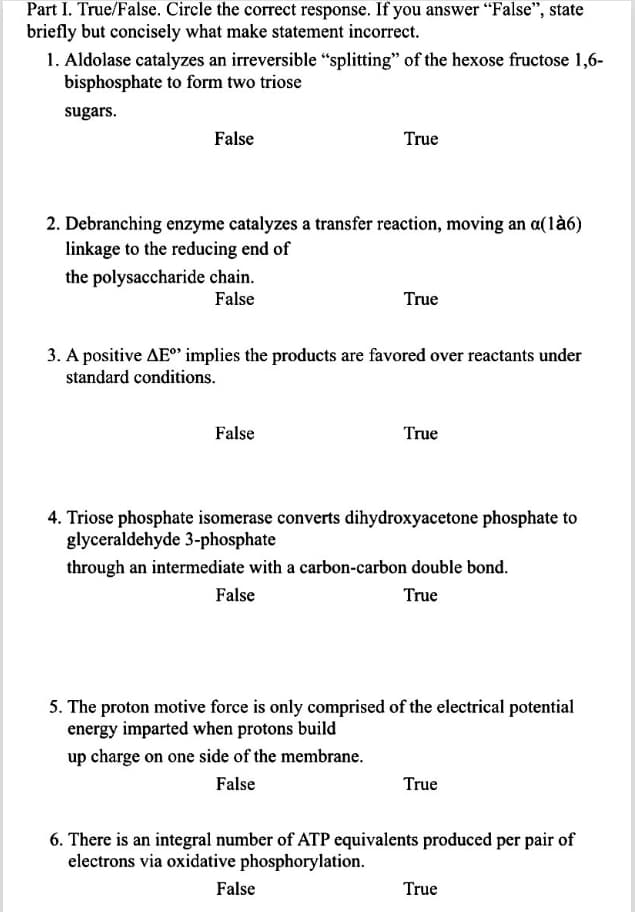1. Aldolase catalyzes an irreversible "splitting" of the hexose fructose 1,6- bisphosphate to form two triose sugars. False True 2. Debranching enzyme catalyzes a transfer reaction, moving an a(là6) linkage to the reducing end of the polysaccharide chain. False True 3. A positive AE implies the products are favored over reactants under standard conditions. False True
1. Aldolase catalyzes an irreversible "splitting" of the hexose fructose 1,6- bisphosphate to form two triose sugars. False True 2. Debranching enzyme catalyzes a transfer reaction, moving an a(là6) linkage to the reducing end of the polysaccharide chain. False True 3. A positive AE implies the products are favored over reactants under standard conditions. False True
Biology 2e
2nd Edition
ISBN:9781947172517
Author:Matthew Douglas, Jung Choi, Mary Ann Clark
Publisher:Matthew Douglas, Jung Choi, Mary Ann Clark
Chapter7: Cellular Respiration
Section: Chapter Questions
Problem 17RQ: The control of which enzyme exerts the most control on glycolysis? hexokinase phosphofructokinase...
Related questions
Question
If it’s false. Can you please explain why? Thank you!

Transcribed Image Text:Part I. True/False. Circle the correct response. If you answer “False", state
briefly but concisely what make statement incorrect.
1. Aldolase catalyzes an irreversible "splitting" of the hexose fructose 1,6-
bisphosphate to form two triose
sugars.
False
True
2. Debranching enzyme catalyzes a transfer reaction, moving an a(là6)
linkage to the reducing end of
the polysaccharide chain.
False
True
3. A positive AE implies the products are favored over reactants under
standard conditions.
False
True
4. Triose phosphate isomerase converts dihydroxyacetone phosphate to
glyceraldehyde 3-phosphate
through an intermediate with a carbon-carbon double bond.
False
True
5. The proton motive force is only comprised of the electrical potential
energy imparted when protons build
up charge on one side of the membrane.
False
True
6. There is an integral number of ATP equivalents produced per pair of
electrons via oxidative phosphorylation.
False
True
Expert Solution
This question has been solved!
Explore an expertly crafted, step-by-step solution for a thorough understanding of key concepts.
This is a popular solution!
Trending now
This is a popular solution!
Step by step
Solved in 3 steps

Knowledge Booster
Learn more about
Need a deep-dive on the concept behind this application? Look no further. Learn more about this topic, biochemistry and related others by exploring similar questions and additional content below.Recommended textbooks for you

Biology 2e
Biology
ISBN:
9781947172517
Author:
Matthew Douglas, Jung Choi, Mary Ann Clark
Publisher:
OpenStax

Biology 2e
Biology
ISBN:
9781947172517
Author:
Matthew Douglas, Jung Choi, Mary Ann Clark
Publisher:
OpenStax